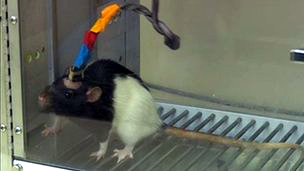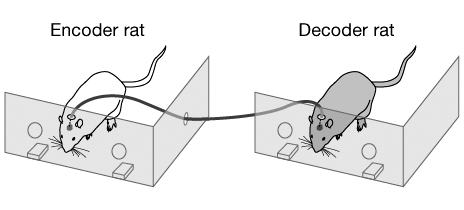Rats Communicate From Brazil to U.S.
Duke University Medical Research
Clinical research studies at Duke University Medical Center, led by Professor Miguel A. Nicolelis who is a professor of neurobiology, have successfully proven that rats can communicate when an electrode is implanted in the rats.
One of the encoder rats is located at the University of Natal, Brazil, and the decoder rat is located at Duke University. This is medical research that has enormous implications in the future. The professor thinks we may learn to communicate with each other telepathically. It sure would be different if we had no need to talk, just think. This research is reported in the Journal Scientific Reports.
Brain to Brain

Facts of This Medical Research
The research team had discovered in previous studies that the rat brain would adapt easily to input devices outside the body, and they also learned to process infrared light that is invisible, which is generated by artificial sensors. Then, the question became could the brain also “assimilate information input from sensors from a different body”.
Initially, the pair of rats was trained to solve a simple problem. When they pressed the correct lever, which was indicated by an infrared light above the lever, they received a reward of water. Then, the scientist connected an array of micro electrodes, which were inserted into the area of the brain that processes motor information. These micro electrodes used in the rodents were about one hundredth of the diameter of a human hair.
Medical Study Procedure
One rat was designated the encoder rodent, and the other rate was the decoder rodent. Therefore, the job of the first rat, located in Brazil, was to press the lever to receive water. The electrical activity from this encoder rat’s brain was translated into a signal, which was received by the decoder rat. This rat pushed his lever, but his lever did not have a light.
As there was no light, this rat had to receive and interpret the signal to know which lever to push. The decoder rat chose the right lever, which would be on the left or the right. The chose the correct lever 70 percent of the time.
In addition, when the decoder rat was incorrect, the encoder rat did not get a full reward. Therefore, the encoder rat actually changed its brain function to make the task easier for the decoder rat.
This process is referred to as “behavioral collaboration” between the rats. Clearly, the encoder rat was motivated to get that extra reward. This teaching process took 45 days of training for one hour daily.
One Rat with Electrodes

Clinical Trial Studies Results
What is the implication of these results? The scientists believe it will be possible to connect literally millions of brains to tackle the same problem, thus sharing a solution. Professor Nicolelis has stated that this idea could extend to humans. He said one day we may be able to communicate with each other through telepathy.
The professor further stated, “We will have a way to exchange information across millions of people without using keyboards or voice recognition devices or the type of interfaces that we normally use today.” He predicts this happening over the next few decades.
Rats Connected

Possible Results
Obviously, the scientist will have to develop non-invasive technology for sharing information between brains. Informed consent is another important aspect as well.
Can you imagine how bombarded some people’s brains would be if everyone could communicate withput speaking? World leader or maybe CEOs of big companies would surely get more input than they desire
Future of this Clinical Study
One of the other discoveries in this study was the decoder rat’s brain represented its tactile cortex, not only for his own whiskers, but also the encoder’s whiskers. The rat actually responded to “both sets of whiskers, which means that the rat created a representation of a second body on top of its own." These adaptations have led to a new field of study, named Neurophysiology of social interaction.
The researches plan to record 2,000 brain cell signals at one time. Over the next five years they hope to record electrical brain signals being produced simultaneously for 10-30,000 cortical neurons. If they can accomplish this, they will be able to learn more about neuroprostheses, similar to the Walk Again Project.
This project for paralyzed people was founded to restore motor control. This project received a $20,000,000 grant from a Brazil research facility for development of the first exoskeleton that is brain controlled. They will present a demonstration of the technology at the 2014 Soccer World Cup in Brazil
Rats mind-reading technology: Scientists create 'telepathic' connection
Implications of Brain Studies
Do you think that these types of studies will lead to great advancements for human beings to communicate?
Conclusion
The implications of this work are fascinating. They are very likely to cure paralysis in the decade. The studies on the human brain may lead to a cure for epilepsy and a myriad of other diseases. The other aspects regarding communicating are also fascinating to consider. Scientists are making great strides in understanding the brain and how it functions.
© 2013 Pamela Oglesby







